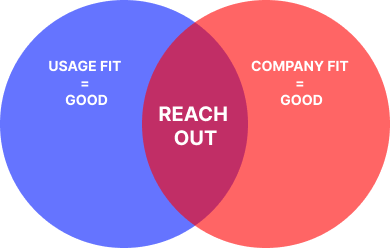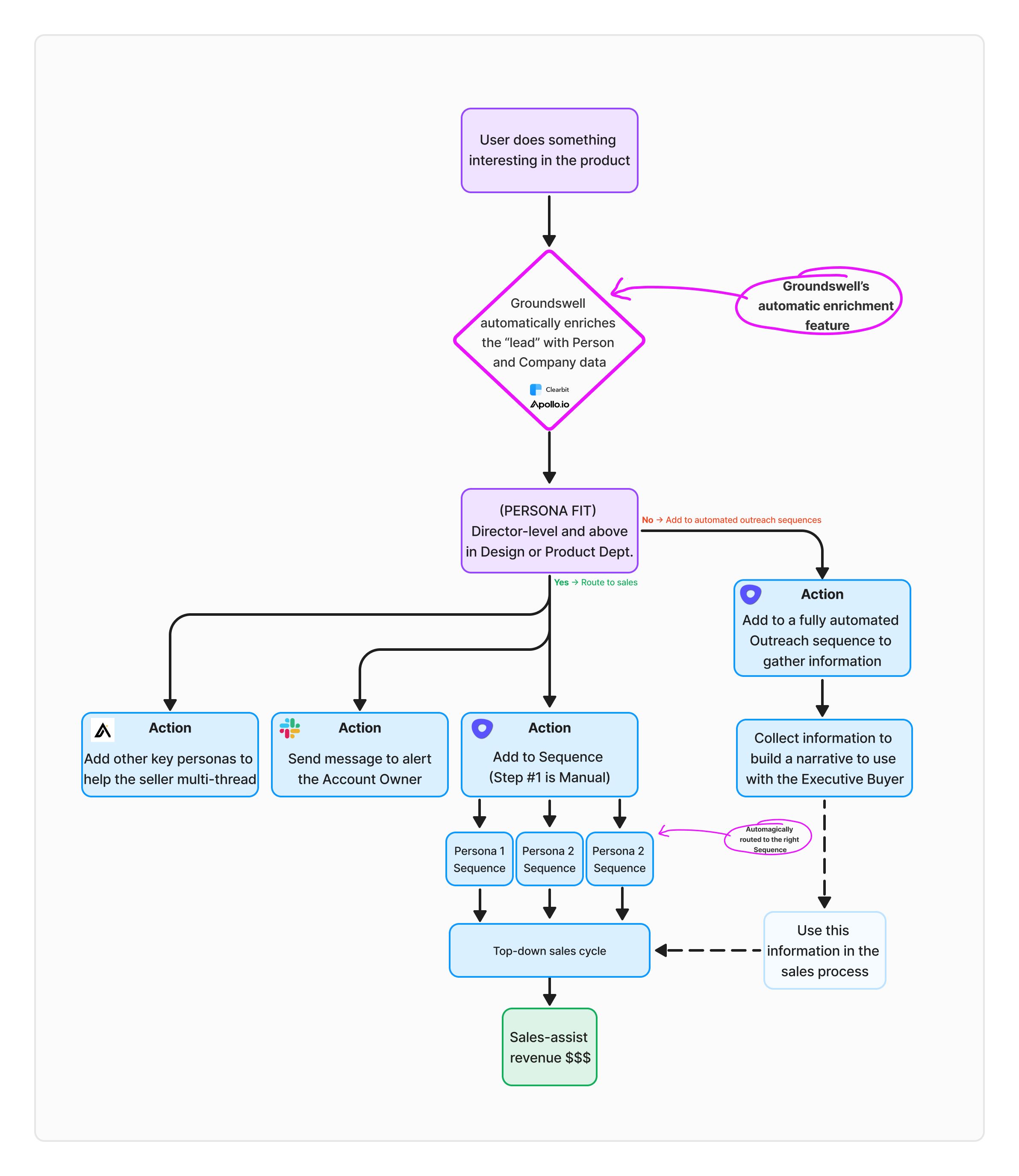Enrichment unlocks key use-cases in product-led sales 🔑
Enrichment unlocks key use cases in product-led sales
So you have users signing up and using your product. Great!
But there’s a problem. You don’t know which of these users are most likely to become a customer. And you want your team to spend their time as efficiently as possible.
Because someone using your product a lot does not necessarily mean they’ll be a good customer.
The goal of doing product-led sales well is very simple: your sales team should be reaching out to people when there is “good usage” and it’s a “good company fit.”

Sales-assist vs. Self-serve
Modern GTM Orgs use Groundswell to automagically add certain product users at “Tier 1 Companies” into the relevant email sequences on behalf of the right sales rep. This is the “sales-assist” path.
And they use Groundswell to automagically add users from “Tier 2 Companies” into automated flows owned by product and/or marketing. This is the “self-serve” path.
One of the promises of being “product-led” is better serving users.
Most people agree that you should have “personalized journeys” depending on the person and company that signs up for your product, and depending on what that person does (or doesn’t do) in your product. Sometimes sales should be involved (aka “sales assist”) and sometimes the user should just get fully automated outreach from marketing.
But, you can’t create personalized journeys without having data about the person using the product, and their company. It always comes back to the data!
We noticed that Groundswell customers kept wanting to create different “Plays” based off of 3rd Party data, and they didn’t always have that information.
So we decided to partner with Apollo and Clearbit to automatically enrich the data of our customers, so that they can get the full benefits of using enrichment data within their product-led sales motion.
“Enrichment data” is 3rd Party data on the Company (eg: size, location, technographics, etc.) and on the People (eg: title, department/seniority, location, etc.).
Two examples of leveraging enrichment data in product-led sales
One important caveat to the examples below: in the early days of a product, you should reach out to every single sign-up, regardless of the size of company or title of the person. There is a lot you can learn by reaching out to your early product users.
1/ Company enrichment
Your reps have hundreds of people they could reach out to on a daily basis, and a dozen tools they could look at to make that decision.
But the reality is, some of those people are more likely to convert to revenue based on how good of a fit the company is for your business, in addition to what users are most active in your product recently.
What determines a “good fit”? It’s different for every company and usually is a combination of data points, but some obvious examples include: employee count, funding, technologies used, location, growth of a particular department, current strategic initiatives at the company, just to name a few.
Let’s look at how Groundswell’s automatic enrichment service works, using a common example: employee count.
When your product users are enriched with employee count, you can create rules off the back of this data. So, you could say: for anyone who signs up and is at a company with under 100 employees, put that person through the automated onboarding process (aka the self-serve funnel). No need for a rep to reach out manually. For anyone who signs up and works at a company with over 100 employees, put that person through the manual onboarding process (aka sales-assist funnel), which includes a rep being alerted, researching and personally reaching out to the person. And perhaps even finding other people at the company to go reach out to. Here’s a visualization of this example:

2/ Person enrichment
Sales reps spend a lot of their time figuring out who is using the product. As they should. Because who is using your product is the highest “intent signal” that exists. Reps are sifting through user data to answer questions like: are they end users? Are there people in clusters in a certain department or geographic location? Something else? Reps are trying to understand the narrative behind what’s happening within the usage of your product.
Let’s say you’re an Enterprise Rep for Figma. Designers are the core “end users” for Figma. But the “Decision Maker” (or “Executive Buyer”) is often the VP of Product or Design.
For an Enterprise Company, you may not want to reach out to every single Designer (aka End User) who signs up. Of course, they should still go through a personalized (automated) onboarding process that is owned by your Marketing Team. But if a Director-level or above title signs up and they’re part of the Product/Design department, you should have them go through the manual onboarding process, which includes a rep being alerted, researching and manually reaching out to that person 1:1. Here’s a visualization of this example:

Conclusion
The two examples we walked through today are fairly simple examples.
But there is a big unlock when you start enriching data and will lead to massive efficiencies within your GTM Organization. Especially as you start automating actions on behalf of your reps, which frees up their time to focus on building customer relationships.
We’d love to help your GTM Org become more efficient this year. And built-in data enrichment is a critical part of making that happen at scale.
If you want to learn how we can specifically help your company's product-led sales motion by leveraging Groundswell's automatic enrichment product, please reach out to us today!